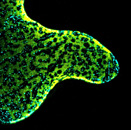Arabidopsis Remorins
 Remorins have frequently been shown to be activated during plant-microbe interactions (reviewed in Jarsch and Ott, 2011). However, most of these genes are ubiquitiously expressed in plants suggesting that they may serve housekeeping functions. To approach their roles within plant cells we are generating homozygous k.o. mutants against most of the 16 remorins from Arabidopsis thaliana. These mutants are currently under detailled phenotypical investigation and first double mutants have been created. Furthermore all remorins from A. thaliana have been cloned in our lab and expressed as fluorophore-tagged fusion proteins to study their subcellular localisation. We recently showed that these proteins label a wide range of different, co-existing micro-domains (Jarsch et al., 2014). We have currently placed our main focus on the analysis of remorins during plant-microbe interactions but recent findings also direct us to investigate aspects of plant developmental biology in more detail. Published data suggesting involvement of remorins in phytohormone-mediated pathways seem possible since transcript levels of AtDbp (AtREM1.3) are elevated upon treatment with auxin (Alliotte et al., 1989). Data obtained from co-immunoprecipitation experiments of AtREM1.3 also support this hypothesis since this remorin appears to interact with the response regulator ARR4 (Yamada et al., 1998) that is involved in cytokinin-dependent pathways. Interestingly several members of the remorin family were found to be differentially regulated during plant microbe interactions indicating functions during microbial infections and related plant signaling processes (Coaker et al., 2004; Campo et al., 2008; Rocco et al., 2008; Widjaja et al., 2009; Jarsch and Ott, 2011).
Remorins have frequently been shown to be activated during plant-microbe interactions (reviewed in Jarsch and Ott, 2011). However, most of these genes are ubiquitiously expressed in plants suggesting that they may serve housekeeping functions. To approach their roles within plant cells we are generating homozygous k.o. mutants against most of the 16 remorins from Arabidopsis thaliana. These mutants are currently under detailled phenotypical investigation and first double mutants have been created. Furthermore all remorins from A. thaliana have been cloned in our lab and expressed as fluorophore-tagged fusion proteins to study their subcellular localisation. We recently showed that these proteins label a wide range of different, co-existing micro-domains (Jarsch et al., 2014). We have currently placed our main focus on the analysis of remorins during plant-microbe interactions but recent findings also direct us to investigate aspects of plant developmental biology in more detail. Published data suggesting involvement of remorins in phytohormone-mediated pathways seem possible since transcript levels of AtDbp (AtREM1.3) are elevated upon treatment with auxin (Alliotte et al., 1989). Data obtained from co-immunoprecipitation experiments of AtREM1.3 also support this hypothesis since this remorin appears to interact with the response regulator ARR4 (Yamada et al., 1998) that is involved in cytokinin-dependent pathways. Interestingly several members of the remorin family were found to be differentially regulated during plant microbe interactions indicating functions during microbial infections and related plant signaling processes (Coaker et al., 2004; Campo et al., 2008; Rocco et al., 2008; Widjaja et al., 2009; Jarsch and Ott, 2011).
Literature cited:
Alliotte S, Tire C, Engler G, Peleman J, Caplan A, Van Montagu M, Inze D (1989); An auxin-regulated gene of Arabidopsis thaliana encodes a DNA-binding protein. Plant Physiol, 89: 743-752
Campo S, Manrique S, García-Martínez J, San Segundo B (2008); Production of cecropin A in transgenic rice plants has an impact on host gene expression. Plant Biotechnol J, 6: 585-608
Coaker GL, Willard B, Kinter M, Stockinger EJ, Francis DM (2004); Proteomic analysis of resistance mediated by Rcm 2.0 and Rcm 5.1, two loci controlling resistance to bacterial canker of tomato. Mol Plant Microbe Interact, 17: 1019-1028
Jarsch IK, Ott T (2011); Perspectives on Remorin Proteins, Membrane Rafts, and Their Role During Plant–MicrobeInteractions. Mol Plant Microbe Int, 24:7-12
Jarsch IK, Konrad SSA, Stratil TF, Urbanus SL, Szymanski W, Braun P, Braun KH, Ott T (2014)
Plasma Membranes Are Subcompartmentalized into a Plethora of Coexisting and Diverse Microdomains in Arabidopsis and Nicotiana benthamiana. The Plant Cell, 26: 1698-1711
Rocco M, Corrado G, Arena S, D'Ambrosio C, Tortiglione C, Sellaroli S, Marra M, Rao R, Scaloni A (2008); The expression of tomato prosystemin gene in tobacco plants highly affects host proteomic repertoire. J Proteomics, 71: 176-185
Widjaja I, Naumann K, Roth U, Wolf N, Mackey D, Dangl JL, Scheel D, Lee J (2009); Combining subproteome enrichment and Rubisco depletion enables identification of low abundance proteins differentially regulated during plant defense. Proteomics, 9: 138-147
Yamada H, Hanaki N, Imamura A, Ueguchi C, Mizuno T (1998); An Arabidopsis protein that interacts with the cytokinin-inducible response regulator, ARR4, implicated in the His-Asp phosphorylay signal transduction. FEBS Lett, 436: 76-80

